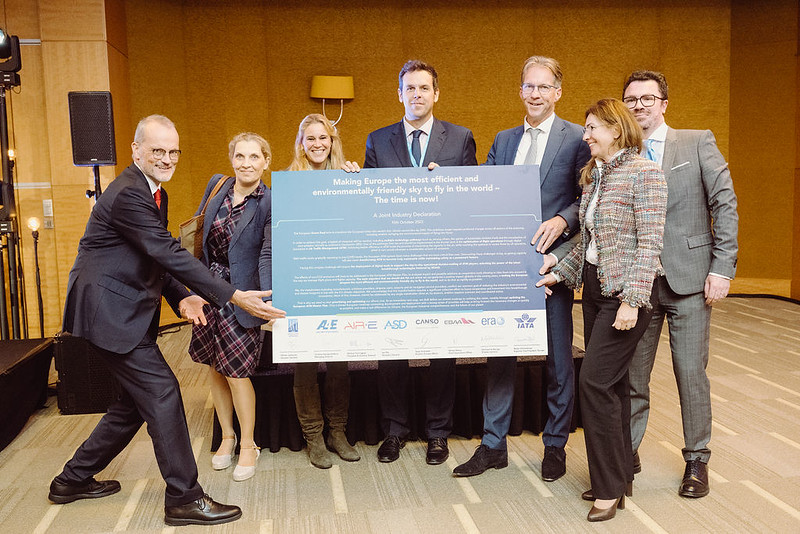Source: SESAR
A total of 400 stakeholders gathered in Brussels on 10 October for the second SESAR 3 Joint Undertaking annual conference, which saw the launch of a campaign to update the European ATM Master Plan 2024, the roadmap for the modernisation of Europe’s air traffic management system to maximise its contribution to delivering “the most efficient and environmentally-friendly sky to fly in the world”.
The updated Master Plan – which will have sustainability at its core, given the urgent need to decarbonise the aviation sector as part of the drive to make Europe’s economy carbon-neutral by 2050 – will set out the vision and ambitions required to meet that goal.
Magda Kopczynska, the European Commission’s Director-General for Mobility and Transport, highlighted the key role that SESAR is playing in developing the solutions needed to achieve that objective, describing the last 12 months as “a year of delivery for the whole SESAR project”.
She said that much is expected of aviation sector when it comes to meeting the sustainability and decarbonisation challenge, adding that SESAR is “in the right place” to help meet those expectations, following the successful completion of the SESAR 2020 programme and the launch of the SESAR 3 Joint Undertaking.
This was echoed by Raul Medina, Director-General of Eurocontrol, who said: “We know our sector can achieve amazing things if we put our minds to it…and SESAR is the place where that magic – those transformative ideas – happens.”
Master Plan and the environment
SESAR, the European Union Aviation Safety Agency and Eurocontrol used the conference to publish a joint discussion paper designed to shape and fuel the debate on the way forward, by highlighting some of the key questions that need to be answered in order to update the Master Plan’s vision and identify the key research and deployment priorities needed to realise that vision.
The campaign also received strong support from the aviation industry, with the publication of a declaration underlining what LVNL CEO Michiel van Dorst said was the sector’s strong and continued commitment to delivering a “shared roadmap on how we will bring this vision to reality”, with clear priorities connecting development and deployment.
Speaking on behalf of the Spanish EU Presidency Alvaro Fernandez-Iruegas, Deputy Director-General of the Spanish Civil Aviation Authority, underlined the challenges facing the aviation sector and said the current ATM system “has almost reached its limits”. He voiced his country’s strong support for the work being done by SESAR to meet these challenges.
Underlining what he called the “significant alignment” between the International Civil Aviation Organisation and SESAR, ICAO Secretary-General Juan Carlos Salazar said the conference held “the promise of ramping up momentum towards a number of our common priorities”.
Andreas Boschen, Executive Director of the SESAR 3 JU, told the audience: ”We are looking forward to working with all partners and stakeholders for an ambitious and realistic Master Plan bringing development and deployment closer together.”
Delivering change
He highlighted the achievements of SESAR to date: 127 solutions, of which some 100 of which are making a positive contribution to the environment and have the potential to reduce CO2 emissions by 4% per flight, a significant contribution towards the current target. But he added: “Let’s raise the bar for the next edition of the European ATM Master Plan. We have to ask ourselves if the ambition on environment in the current edition goes far enough? Is 5-10% emissions reduction sufficiently ambitious and what about noise, air and non-CO2 emissions?”
The SESAR 3 JU will have nine months to build consensus on the Master Plan’s vision and the key research and deployment priorities it should contain. This phase will be followed by a more formal discussion ahead of the Master Plan’s adoption towards the end of next year.
A key theme throughout the conference was the urgent need to accelerate the deployment of the solutions that have already been developed to bring about the digital transformation of ATM.
“We have a lot of advanced tools, but we have not seen a lot of those solutions deployed,” said Marc Baumgartner, from IFATCA , the global organisation representing air traffic controllers. This was echoed by Hermann Mattanovich, Chief Technology Officer of Frequentis, who said: “We have done 80% of it, but the remaining 20% is the hard part”, and by Jörg Pikolin, Head of ATM Development at the Lufthansa Group, who said there was a clear business case for implementing the solutions already developed and added: “As an industry, we have to be more entrepreneurial and take risks.”
Spotlight on innovation
More than 30 SESAR projects were on display at an exhibition showcasing the work that is being done under the auspices of the SESAR 3 JU in key areas from connected ATM to U-space and Air Ground Integration and from multimodality and the aviation green deal, to capacity and demand, virtualisation and cyber security.
Closing the conference, Andreas Boschen thanked participants warmly for their contributions to the debate, saying: “All this input is very encouraging for us. We have taken stock and opened the trajectory towards a digital and green European sky. Now we need ambition and, where necessary, a spirit of compromise.”

